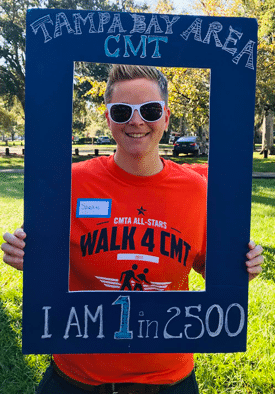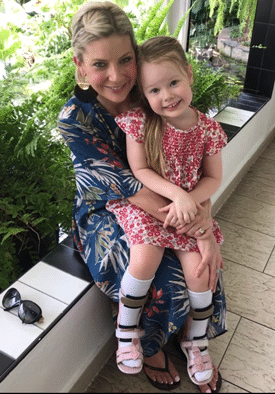
Caroline’s journey with a rare and serious form of CMT began when she was just 9 months old. Today, a cure for Caroline may open the door to treatments and a cure for CMT!
A Unique Gene Therapy for Caroline May Open the Door That Will Change the Lives of 2.8 Million People Around the World
At the age of nine months Caroline began a turn in the wrong direction compared to her twin brother. Crawling became harder, then nonexistent. She could no longer hold things, and then the progressive decline in muscle function was noted by all. Many specialists working from different perspectives could not pinpoint the problem. Eventually a single genetic mutation was discovered but whether it caused the problem remained a puzzle. A team of researchers at the University of Michigan was challenged to find the answer. The answer was yes, the mutation was the culprit. A new team at the Jackson Laboratory in Bar Harbor, Maine was asked to develop a mouse model of the problem. They did. The experts in gene therapy at the Ohio State University and Nationwide Children’s Hospital were contacted and asked to see if they could offer a solution to the problem caused by this mutation. They could. The mice were treated with the gene therapy. They improved.
This short story hopefully does not stop here.
Caroline’s disease involves a mutation in a gene that codes or makes an enzyme that is necessary for nerves to work. Since this was the first discovery of a new medical entity, it was hard to classify her problem. Her progressive loss of muscle was similar to other diseases that are being diagnosed with increasing frequency such as spinal muscular atrophy (SMA), amyotrophic lateral sclerosis (ALS or Lou Gehrig’s disease) and even spinal cord injury. Her problem seemed to share many characteristics with a particular inherited nerve problem called Charcot-Marie-Tooth disease. Her disease found a home, classified as an extremely rare and serious subtype of Charcot-Marie-Tooth disease.
Charcot-Marie-Tooth Disease affects 2.8 million people worldwide accoring to the Charcot-Marie-Tooth Association. The symptoms and physical problems are quite variable from patient to patient, from difficulty with movement due to weakness in the muscles to chronic nerve pain and joint pain. Caroline’s severe case keeps her from walking or using her hands. She uses a ventilator at night because of weakness in her respiratory muscles.
Part Two begins.
When the mice at the Jackson Lab improved with gene therapy, hope began for Caroline. Replication of the improvement over many trials led the teams to decide a human treatment was feasible. We are at that point today. The reproducible mouse data leads researchers to believe that an improvement in Caroline, who has a genetic mutation, opens the door for that 2.8 million or more patients who have an inherited form of Charcot-Marie-Tooth disease. Attaching a piece of good gene to a virus that eventually goes to every cell in the body and blocks the bad gene is the simplified version of the treatment. The $2.6 million needed to develop this single treatment will have high impact considering the number of patients that may benefit.
We ask your help to keep the story going to improve the lives of children and adults with CMT and to potentiate treatments for other diseases that may be caused by alterations in our genetic makeup. Please donate now and help support the development of this treatment.
Sarah: Life with CMT2X

Meet Sarah! A CMTA Camp Footprint Counselor, Sarah shares her journey with CMT2X.
My Diagnosis
Growing up, I always had trouble with balance. Hurdles were not my favorite activity in grade school gym class nor was skiing. My Mom was diagnosed with CMT in 2012 and I was told that I could potentially have it but I never thought to go through genetic testing. In May of 2018, I decided to take the plunge after Dr. Jerath visited the Tampa Bay CMT Branch and discussed the importance of genetic testing. A few weeks later, at age 33, I found out that I had CMT 2X.
How CMT2X Affects My Daily Life
CMT 2X is an autosomal recessive, slowly progressive, axonal peripheral sensorimotor neuropathy characterized by lower limb muscle weakness and atrophy. What does this truly mean? I struggle with balance, fatigue and diminishing strength in my hands and legs.
I’ve noticed most recently that my fatigue levels, balance and diminishing strength in my hands and legs have tried to put a damper on my daily life. However, I am determined to keep enjoying my daily life activities that include working at a local university, staying active and preparing for my wedding!
How I Got Involved with the CMTA
In 2016, my Mom was visiting for Mother’s Day and we decided to go to our first ever CMT Branch meeting in Sarasota. It was my first ever experience meeting folks with CMT. I have always been quite enamored about the available programming, research and CMT Center of Excellences so I thought, why not? At the meeting, the Sarasota Branch Leader, Rachel, mentioned that the CMTA was looking for volunteers to serve as Camp Counselors for Camp Footprint. After mingling with the fellow members and hearing more about the opportunity to be a counselor – I was ecstatic and decided to serve as a camp counselor. From that day forward, I was honored to be a part of the CMTA community.
What the CMTA Means to Me
The CMTA has been an extremely welcoming and supportive community to my family and I. Both my partner and I plan to serve as camp counselors for Camp Footprint this summer. Throughout the year, I serve as a technical support liaison for the CMT Walk Program and I am an active member of the Tampa Bay CMT group. Being a part of the CMTA community has been wonderful and I consider many of the community members and CMTA staff part of my family.
Scarlett’s Journey with CMT2S

This is Scarlett and her Mom enjoying an outing together. Scarlett has a diagnosis of CMT2S and lives with her Mom and Dad in their home country of Australia.
Scarlett’s Diagnosis
When Scarlett started walking at about 14 months, she was very unsteady. This eventuated in frequent tripping, high stepping, and foot drop. At first, Scarlett was tested with an MRI for a possible brain tumor. After this was ruled out, genetic testing revealed defects in the IGHMPB2 gene and Scarlett was diagnosed with a rare form of CMT called CMT2S.
About CMT2S
CMT type 2S is a newly discovered form of CMT caused by defects in the same gene that is known to cause Spinal Muscular Atrophy with Respiratory Distress (SMARD). It is autosomal recessive, meaning that both parents must be carriers of the defective gene in order to pass it on, and each child of two parents who are carriers would have a one in four chance of inheriting the disorder.
This form of CMT causes progressive distal muscle weakness and atrophy of both the lower and upper limbs, absent or reduced deep tendon reflexes, mild sensory loss, foot drop, and high arch.
Some forms of CMT2S can later progress and become more similar to SMARD1 which affects the breathing muscles, can lead to scoliosis, and can cause children to be ventilator-dependent. What causes CMT2S to be more severe in some children but not in others is unknown and currently being researched. Children with defects in the IGHMPB2 who have hand and foot weakness are generally diagnosed with CMT2S, while more severe symptoms with respiratory involvement often receive a diagnosis of SMARD.
How CMT2S Impacts Life for Scarlett
As she is quite accident prone, Scarlett attends regular physio and has carers at kindergarten. Life can be quite busy as Scarlett needs help on a daily basis with some tasks, including eating, due to hand weakness. However, she remains independently walking and is a really happy, beautiful child! Scarlett sees a neurologist twice a year, and also sees the CMT team at Westmead, a respiratory therapist, orthopedic specialist, and occupational therapist. She is regularly checked for respiratory function and scoliosis.
Scarlett’s treatment involves hydrotherapy, regular stretching, physiotherapy, AFOs, and regular serial casting to stretch the muscles to prevent high arch, varus foot deformity, and Achilles’ tendon shortening. This has been really successful at keeping her walking well independently in AFOs. Currently, Scarlett is casted four days on and three days off every three to four months. This rapid casting helps to prevent weakness.
How the CMTA Helps
I (Scarlett’s Mom) wrote to the CMTA last year to get some more information about CMT2S. Since type 2S was first named in 2014 following the publication of a research article, information on CMT2S was not readily available.
The CMTA invited me to participate on the advisory group. As a member, I attend conference calls and give advice on various projects. It’s been really exciting to participate in making a difference for sufferers of CMT. I’ve particularly enjoyed having input on a really great app that has been developed recently.
There have been exciting research developments lately and currently there is a possible treatment for CMT2S in progress, although funding is limited right now due to the rare nature of the disorder. This recent research involves the AAV9 vector, an approach similar to the treatment of SMA.





